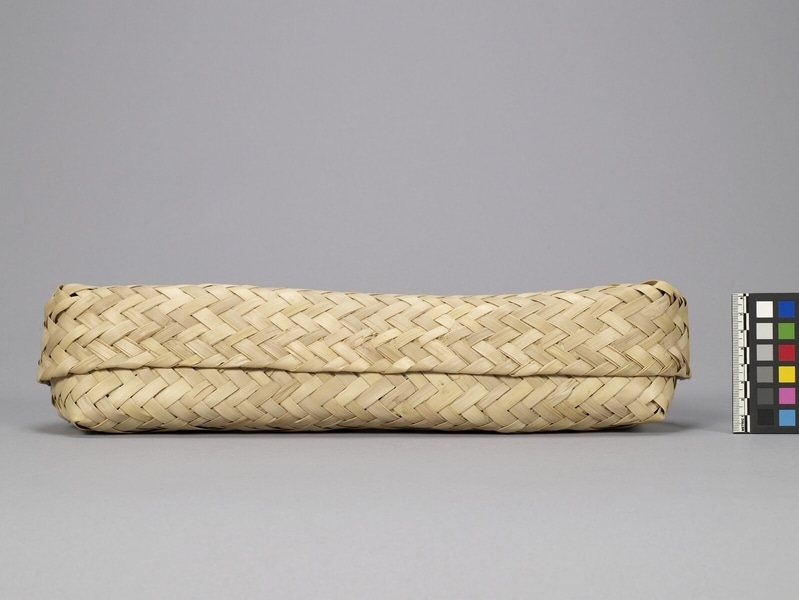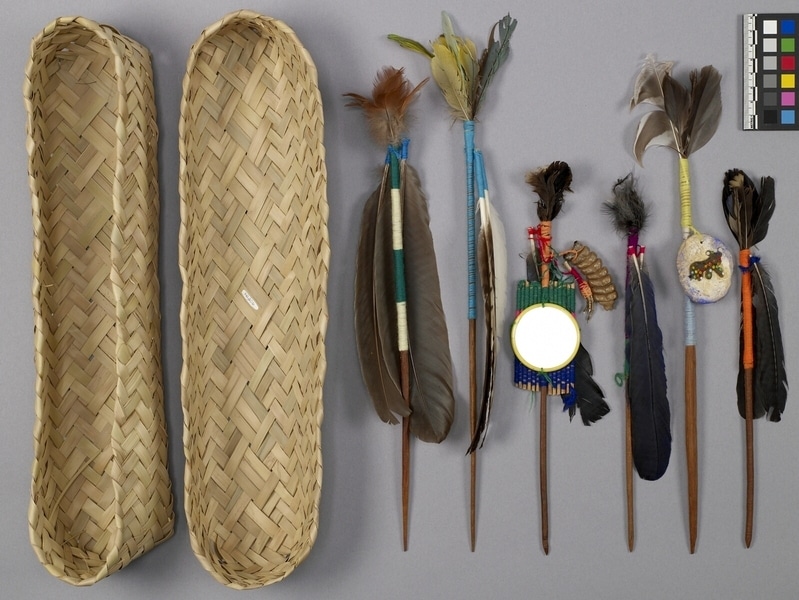Shaman Basket Item Number: Ni30 a-h from the MOA: University of British Columbia



Description
Basket (a) is a rounded rectangle, and has a lid (b) which fits completely over base. Basket contains five wooden arrows. Arrows: (part c) five feathers attached to top, shaft wrapped in bands of yellow and green yarn, two feathers near top attached with blue yarn, all feathers hang freely; (part d) six feathers attached to top, light blue yarn wrapped around shaft; (part e) five feathers at top, orange yarn wrapped around upper shaft attaches a rattlesnake tail and a bird claw, one feather attached with red yarn, back shield of thin sticks is woven together with green, pink and blue yarn, also has a round mirror with a plastic frame; (part f) down-like feathers attached to top, green, purple and pink yarn wrapped around shaft in bands, two feathers attached with red yarn; (part g) four feathers attached to top, bands of blue, white and yellow yarn around shaft, gourd medallion with deer(?) shaped in wax has various coloured seed beads applied; (part h) brown feathers attached to top, orange yarn wrapped along upper shaft, two feathers attached with blue yarn.
History Of Use
Shamanic type basket usually containing a variety of sacred objects collected over his/her apprentice years; items that would aid the shaman in spiritual quests or healing, used extensively during the peyote hunts to control the powers held within the peyote and purify the people on the hunt prior to the ingestion of peyote.
Iconographic Meaning
Feathers mean flight; colours red, yellow, white, purple and speckled symbolize the colours of maize; arrows embody prayers, bands of colours identify their sacred purposes.
Cultural Context
contemporary; tourist art; ritual
Narrative
The Wixáritari are known to the larger world as the Huichol, however that is not the name they use to refer to themselves.
Item History
- Made in Jalisco, Mexico and Nayarit, Mexico before 1980
- Collected during 1980
- Owned by Cicuri Shop
- Owned by Ralph Maud before February 1, 1982
- Received from Ralph Maud (Seller) and Museum of Anthropology Shop Volunteers (Funding source) on February 1, 1982
What
- Name
- Shaman Basket
- Identification Number
- Ni30 a-h
- Type of Item
- basket
- Material
- palm leaf ?, wood, plastic, bee wax, gourd fruit, glass, feather, bird claw and rattlesnake rattle
- Overall
- height 10.0 cm, width 40.0 cm, depth 10.0 cm
- Part A
- height 7.0 cm, width 39.0 cm, depth 9.0 cm
- Part B
- height 6.6 cm, width 40.0 cm, depth 10.0 cm
- Part C
- height 35.0 cm, width 7.5 cm, depth 4.0 cm
- Part D
- height 39.0 cm, width 8.0 cm, depth 3.6 cm
- Part E
- height 28.5 cm, width 4.4 cm, depth 2.0 cm
- Part F
- height 28.0 cm, width 3.0 cm, depth 2.0 cm
- Part G
- height 36.0 cm, width 6.5 cm, depth 4.5 cm
- Part H
- height 27.5 cm, width 4.0 cm, depth 2.0 cm
Who
- Culture
- Huichol
- Previous Owner
- Cicuri Shop and Ralph Maud
- Received from
- Ralph Maud (Seller) and Museum of Anthropology Shop Volunteers (Funding source)
Where
- Holding Institution
- MOA: University of British Columbia
- Made in
- Jalisco, Mexico and Nayarit, Mexico
When
- Creation Date
- before 1980
- Collection Date
- during 1980
- Ownership Date
- before February 1, 1982
- Acquisition Date
- on February 1, 1982
Other
- Item Classes
- basketry
- Condition
- good
- Current Location
- Case 93
- Accession Number
- 0774/0008 a-h